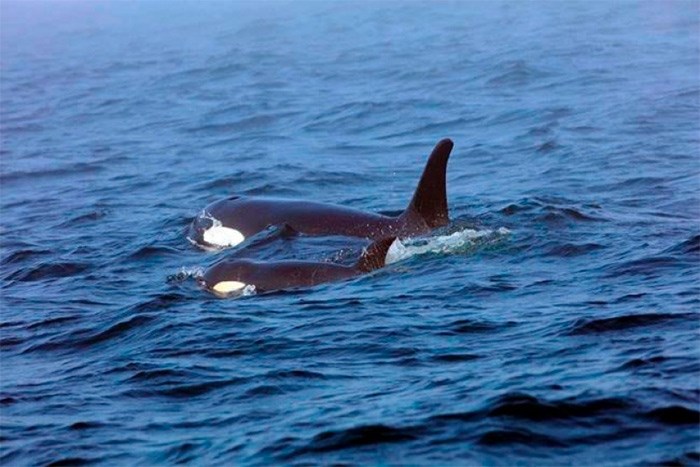 Southern Resident killer whale J50 and her mother, J16, are seen off the west coast of Vancouver Island near Port Renfrew, B.C., on August 7, 2018 in this handout photo. Scientists are reporting progress in the race to help an emaciated and endangered West Coast killer whale in the waters of the Salish Sea. Biologists with the National Oceanic and Atmospheric Association in the United States have tweeted that the team caught up with J50 and her pod near San Juan Island off Washington state. They were able to obtain a breath sample from the juvenile female orca to help assess any infection she might have and they also administered a dose of antibiotics. THE CANADIAN PRESS/HO – Fisheries and Oceans Canada – Brian Gisborne
Southern Resident killer whale J50 and her mother, J16, are seen off the west coast of Vancouver Island near Port Renfrew, B.C., on August 7, 2018 in this handout photo. Scientists are reporting progress in the race to help an emaciated and endangered West Coast killer whale in the waters of the Salish Sea. Biologists with the National Oceanic and Atmospheric Association in the United States have tweeted that the team caught up with J50 and her pod near San Juan Island off Washington state. They were able to obtain a breath sample from the juvenile female orca to help assess any infection she might have and they also administered a dose of antibiotics. THE CANADIAN PRESS/HO – Fisheries and Oceans Canada – Brian Gisborne
Canada’s fisheries minister has fired back at environmental groups for launching court action to protect endangered southern resident killer whales instead of working with the federal government on the issue.
Jonathan Wilkinson said the groups abandoned discussions shortly after they began with federal officials and representatives from the transportation and fishing industries.
“I have to say, personally, I was very disappointed in the action that was taken by the environmental organizations,” he told reporters in Victoria.
“They were the ones who initially asked to convene the multi-stakeholder forum. They effectively attended one meeting and then decided that they would pursue a more adversarial approach rather than a collaborative approach.”
Ecojustice lawyers, acting on behalf of five other conservation groups, launched a Federal Court case against Wilkinson and federal Environment Minister Catherine McKenna this past week. The groups — the David Suzuki Foundation, Georgia Strait Alliance, Natural Resources Defense Council, Raincoast Conservation Foundation and World Wildlife Fund Canada — want the ministers to ask cabinet for an emergency order to protect the orcas.
Christianne Wilhelmson, executive director of the Georgia Strait Alliance, said Friday that the groups were prepared to work with government.
“But the process that they set up was all about talking, not about action,” she said. “It was clear that this was just another process that was going to take months and months and months — and the orcas don’t have that.”
The southern residents, whose numbers have dwindled to 75 in three pods, have been the focus of international attention for weeks.
First, an adult female orca, J35, made headlines after carrying the carcass of her dead calf through the Salish Sea for more than two weeks. Then, an emaciated three-year-old female orca, J50, became the focus of a joint Canada-U.S. rescue effort.
Researchers say a shortage of chinook salmon — the orcas’ preferred food — is one of the main reasons for their decline. Other factors include contaminants in the water and boat noise that interferes with the orcas’ ability to forage for food, researchers say.
Wilkinson insists the federal government has done an “enormous amount” to deal with those concerns.
He cited, among other things, the closure of chinook fishing in three key foraging areas; a 25 to 35 per cent reduction in the chinook fishery this year; a voluntary vessel slowdown in Haro Strait to reduce noise from passing ships; and a new requirement that whale-watching boats and other vessels stay 200 metres away from the orcas — double the previous distance. The construction of new sewage treatment plants in Victoria and North Vancouver will help reduce contaminants in the water, he said.
In addition, the government announced that it wants feedback on two new areas of critical habitat — one off the coast of southwestern Vancouver Island, including the Swiftsure and La Pérouse Banks, and the other in Dixon Entrance.
“We’re very open to implementing new measures if, in fact, we need to do that from a scientific perspective,” he said.
“I think this government is very proud of the work that it’s done and it very much intends to recover the southern resident killer whale.”
But Wilhelmson said the government has taken only “partial” measures to date. “They sound good on first blush, but when you look down, you see that they’re incomplete.”
She said seeking feedback on critical habitat areas is not the same as protecting those areas.
“That habitat may not be designated as critical habitat for another six to eight months, which means nothing changes,” she said.
“It really is misleading to say that they’re doing everything in their power. They’re not. They’re using normal processes, which take months and months, possibly years. Perhaps this is fast for government; it’s not fast enough for the orcas.”



